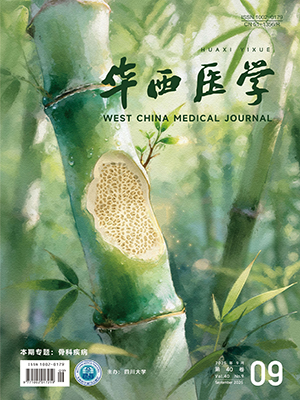| 1. |
Coosney T, Lane A, Bartels U, et al. Contemporary survival endpoints: an International Diffuse Intrinsic Pontine Glioma Registry study. Neuro Oncol, 2017, 19(9): 1279-1280.
|
| 2. |
Hassan H, Pinches A, Picton SV, et al. Survival rates and prognostic predictors of high grade brain stem gliomas in childhood: a systematic review and meta-analysis. J Neurooncol, 2017, 135(1): 13-20.
|
| 3. |
Baugh J, Bartels U, Leach J, et al. The international diffuse intrinsic pontine glioma registry: an infrastructure to accelerate collaborative research for an orphan disease. J Neurooncol, 2017, 132(2): 323-331.
|
| 4. |
任艳明, 肖安琪, 杨翔, 等. 弥漫性脑干胶质瘤研究现状. 华西医学, 2016, 31(4): 775-779.
|
| 5. |
Louis DN, Perry A, Reifenberger G, et al. The 2016 World Health Organization Classification of Tumors of the Central Nervous System: a summary. Acta Neuropathol, 2016, 131(6): 803-820.
|
| 6. |
Makepeace L, Scoggins M, Mitrea B, et al. MRI patterns of extrapontine lesion extension in diffuse intrinsic pontine gliomas. AJNR Am J Neuroradiol, 2020, 41(2): 323-330.
|
| 7. |
Tisnado J, Young R, Peck KK, et al. Conventional and advanced imaging of diffuse intrinsic pontine glioma. J Child Neurol, 2016, 31(12): 1386-1393.
|
| 8. |
Hoffman LM, Veldhuijzen van Zanten SEM, Colditz N, et al. Clinical, radiologic, pathologic, and molecular characteristics of long-term survivors of diffuse intrinsic pontine glioma (DIPG): a collaborative report from the International and European Society for pediatric oncology DIPG registries. J Clin Oncol, 2018, 36(19): 1963-1972.
|
| 9. |
Wm R, Maher E, Adel M, et al. Pediatric diffuse intrinsic pontine glioma: where do we stand?. Cancer Metastasis Rev, 2019, 38(4): 759-770.
|
| 10. |
泮长存, 汤劼, 李德志, 等. 儿童弥漫性内生性脑桥胶质瘤的自然病史及预后因素分析. 中华神经外科杂志, 2015, 31(2): 115-118.
|
| 11. |
Pfaff E, El DA, Balasubramanian GP, et al. Brainstem biopsy in pediatric diffuse intrinsic pontine glioma in the era of precision medicine: the INFORM study experience. Eur J Cancer, 2019, 114(6): 27-35.
|
| 12. |
Aziz-Bose R, Monje M. Diffuse intrinsic pontine glioma: molecular landscape and emerging therapeutic targets. Curr Opin Oncol, 2019, 31(6): 522-530.
|
| 13. |
Mueller S, Jain P, Liang WS, et al. A pilot precision medicine trial for children with diffuse intrinsic pontine glioma-PNOC003: a report from the Pacific Pediatric Neuro-Oncology Consortium. Int J Cancer, 2019, 145(7): 1889-1901.
|
| 14. |
Cooney TM, Lubanszky E, Prasad R, et al. Diffuse midline glioma: review of epigenetics. J Neurooncol, 2020, 150(1): 27-34.
|
| 15. |
Leach JL, Roebker J, Schafer A, et al. MR imaging features of diffuse intrinsic pontine glioma and relationship to overall survival: report from the International DIPG Registry. Neuro Oncol, 2020, 22(11): 1647-1657.
|
| 16. |
Hoster E, Rosenwald A, Berger F, et al. Prognostic value of Ki-67 index, cytology, and growth pattern in Mantle-cell lymphoma: results from randomized trials of the European Mantle Cell Lymphoma Network. J Clin Oncol, 2016, 34(12): 1386-1394.
|
| 17. |
Menon SS, Guruvayoorappan C, Sakthivel KM, et al. Ki-67 protein as a tumour proliferation marker. Clin Chim Acta, 2019, 491(491): 39-45.
|
| 18. |
Janjua MB, Ban VS, El AT, et al. Diffuse intrinsic pontine gliomas: diagnostic approach and treatment strategies. J Clin Neurosci, 2020, 72(72): 15-19.
|




